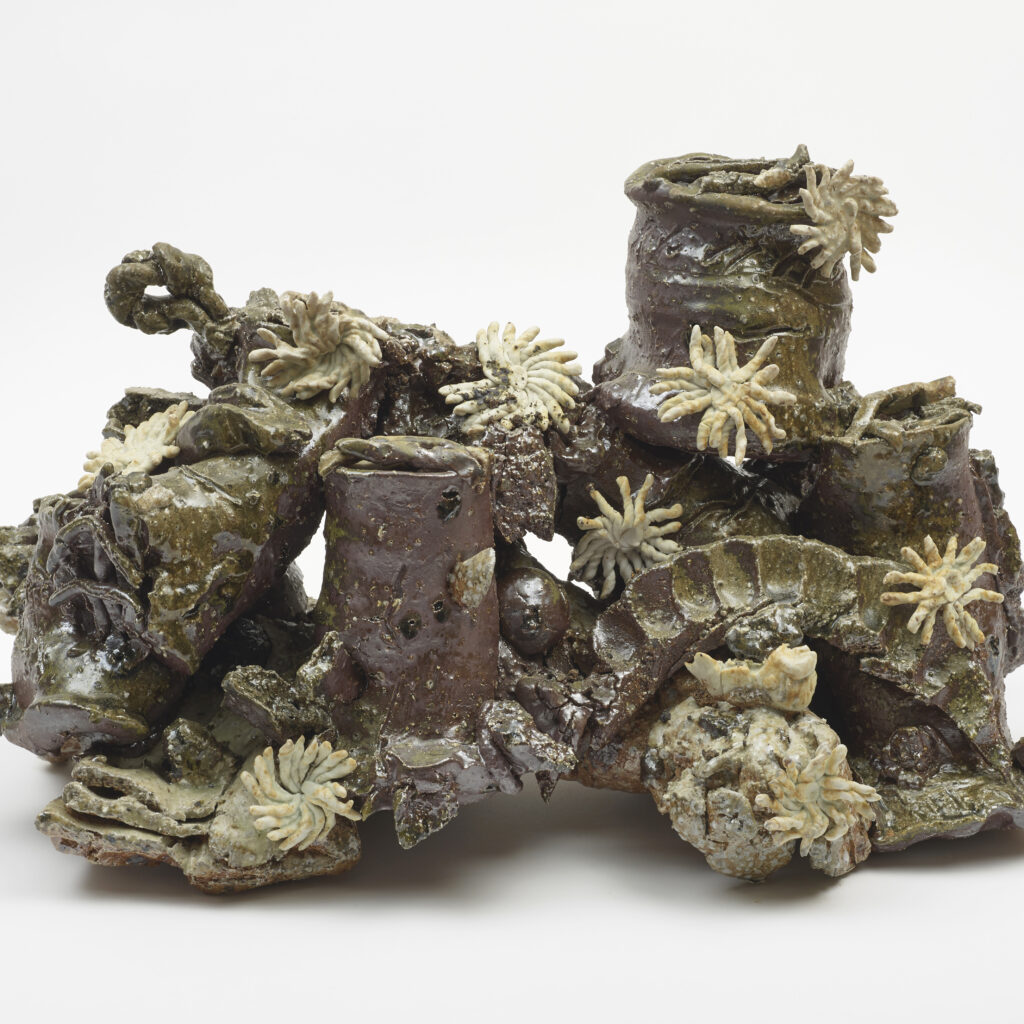Aaron Angell & Steven Claydon: Hornet, hailstone, crab eye, aerodrome…(etc.)
Until 3 January 2022
Hornet, hailstone, crab eye, aerodrome…(etc) presents the results of a recent anagama kiln firing by British artists Aaron Angell (b. 1987) and Steven Claydon (b.1969).
This display is drawn from a firing at Dr Robin Wilson’s Oxford University Kiln Project, an anthropological investigation into this type of ancient pottery kiln, which originally dates from 5th-century Japan, and its continued use by modern practitioners.
‘Anagama’ literally means ‘cave kiln’ and unlike other firings, the works enter the anagama unglazed. The long wood-firing – the kiln was refuelled every six minutes for sixty hours – and the build-up of ash within an open chamber creates an atmospheric glazing from which the organic material is burned off, leaving its mineral content to vitrify and settle on the pots. Both artists regard the physical act of firing as an artwork in itself, an act of devotion and labour.
The Holburne exhibition includes two new bodies of ceramic sculptures from each artist. Angell brings forms that repeat across his practice, such as the frog and the engine block. Claydon looks to Japan’s co-option of ceramic traditions during World War Two; where upon running low on metal stocks due to the Allies cutting off their supply lines, the Japanese Government ordered master ceramicists to build ceramic grenades. He has produced a suite of similar wares and vases, each filled with gunpowder tea and displayed in small groups upon intricately produced laser cut and wood turned structures.
The exhibition’s 500-word title acts the final active component of this shared project, in part stemming from misreadings and mistranslations of metonymic phrases found within the lexicon of Japanese wood-fired ceramic techniques – such as ‘Kani-no-me’ which translates as ‘crab eye’ and refers to spots of melted feldspar in the clay body which erupt from the surface during the firing. This list of misnomers becomes visible and almost poetic via a lino and letterpress print produced at The Wytham Studio, this collaborative work is available to buy in the Museum shop.
The two artists will be In Conversation with Will Cooper, Curator of Contemporary Projects at the Holburne, on Zoom at 7pm 9 December.
Will Cooper says, “I’m delighted to be able to share the fruits of Aaron Angell and Steven Claydon’s recent anagama kiln firing with the Holburne’s audience. While disparate in their individual treatment of works, Claydon and Angell share a rich and impassioned understanding of the history of ceramics rooted in an appreciation (with a healthy skepticism) of British studio potters. Drawing on experiences at the Leach Pottery in St Ives and the firing at Dr Robin Wilson’s Oxford Kiln Project Hornet, Hailstone, Crab Eye… etc. brings the best contemporary thought and process to a traditional craft technique.”
For more information on Holburne Museum follow @Holburne on Twitter, like the Holburne Museum Facebook page, holburnemuseumbath on Instagram or visit www.holburne.org
NOTES FOR EDITORS
Born in London in 1987, Aaron Angell currently lives and works in London. His work is concerned with hobbyist cultures, non-canonical history, and marginal methods of image making. Aaron is also the founder of Troy Town Art Pottery, a radical and psychedelic ceramic workshop for artists in London. Recent solo and group exhibitions include, Rob Tufnell, Cologne; Hauser & Wirth, Somerset (2018); Goma, Glasgow; Tate St Ives, Cornwall (2017); Kunstverein Freiburg (2018) Nouveau Musee National de Monaco (2020), Glasgow International, Glasgow (2016); and Studio Voltaire (2015). www.aaronangell.com
Steven Claydon (b. 1969, London, UK) is a London-based sculptor and musician and has performed and shown work internationally, including at Tate Modern and Switzerland’s Art Basel. He trained at Chelsea School of Art and Design and Central Saint Martins. Steven Claydon describes sound as sculpture and approaches this medium through the senses – combining light, smell, and sound with solid materials to produce artworks that are often not what they might seem on first encounter. A collector of cultural artefacts, Claydon repurposes objects and data into sculptures that are full of intentional contradictions. His work invites the viewer to become the excavator as objects from the past are re-conjured with contemporary materials and new technologies.
The Holburne Museum’s mission statement is ‘Changing Lives Through Art’, signalling its commitment to opening up the enjoyment of art to people of all ages and from every walk of life. The Holburne was founded in 1882 with the gift of Sir William Holburne’s collection of 16th and 17th century Italian and Dutch paintings, silver, sculpture, furniture, porcelain and diverse objets d’art of national and international significance. That founding gift has been augmented with a collection of 18th century paintings by such artists as Gainsborough, Lawrence, Ramsay, Stubbs and Zoffany. Set within the historic Sydney Pleasure Gardens, the Museum reopened in May 2011 after ambitious renovations and with a new, award-winning extension by Eric Parry Architects. The Holburne has since secured a national reputation as an outstanding museum which holds critically acclaimed exhibitions. Its programme of exhibitions, commissions and events sets out to bring to Bath great art of all periods and from around the world, seeking to set the art of the past in dialogue with contemporary practice in exciting and dynamic new ways.

